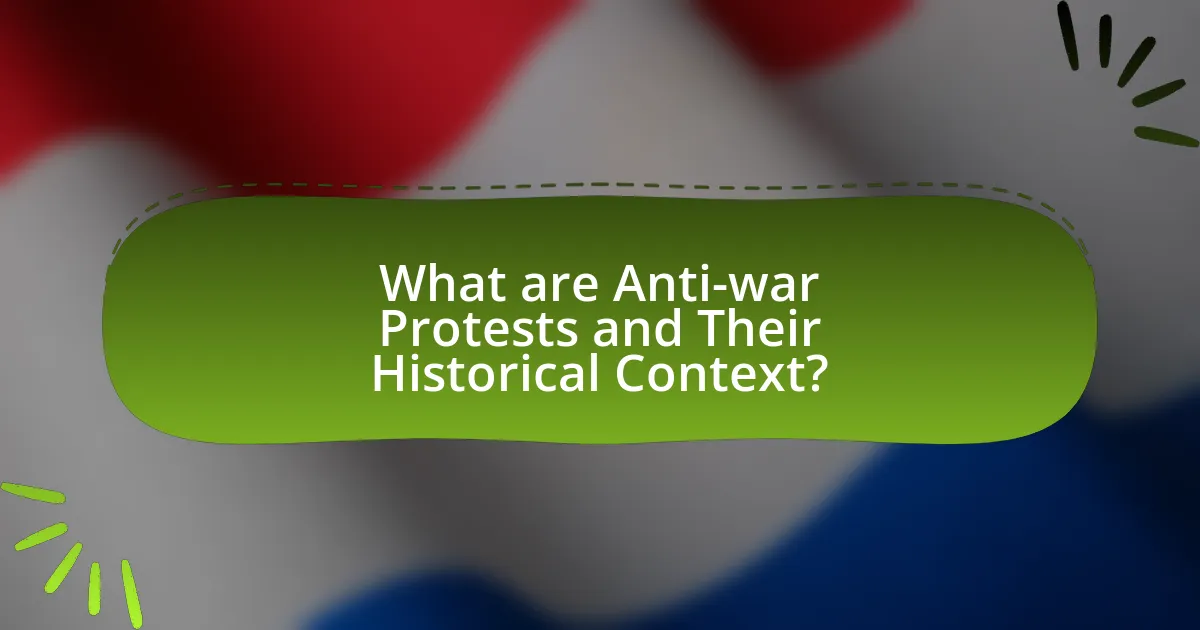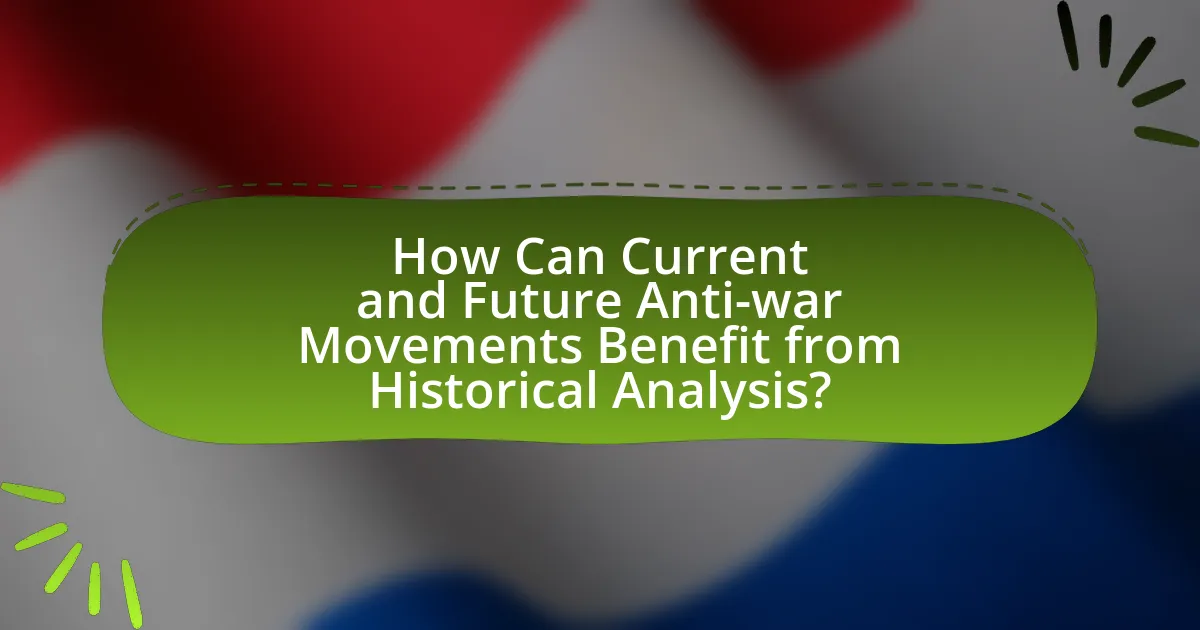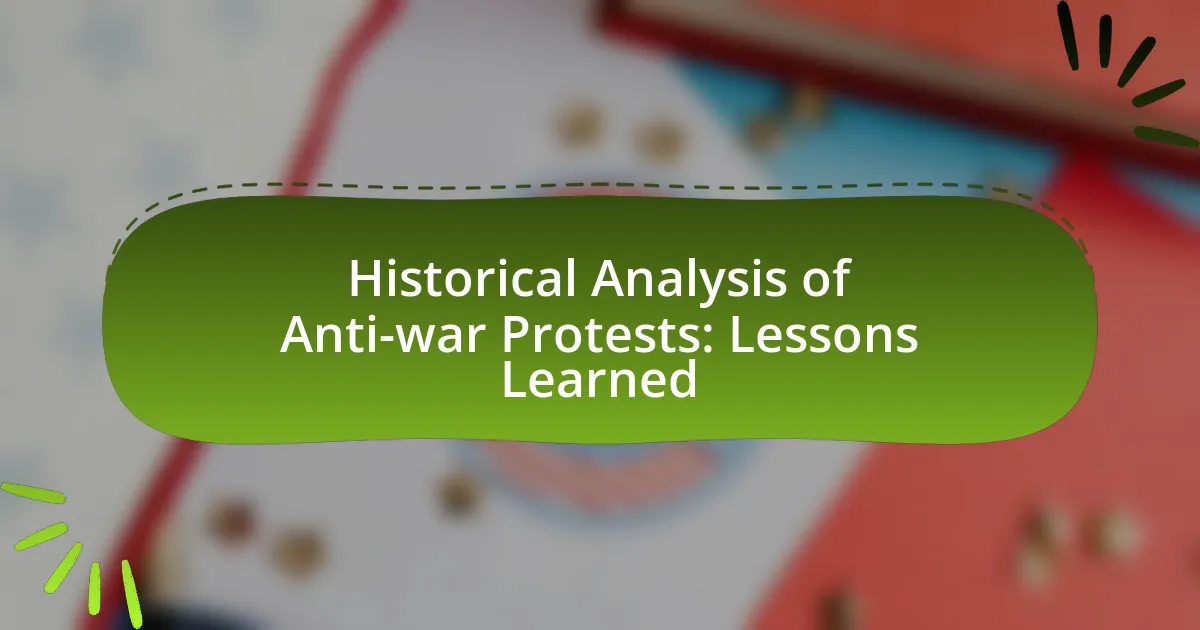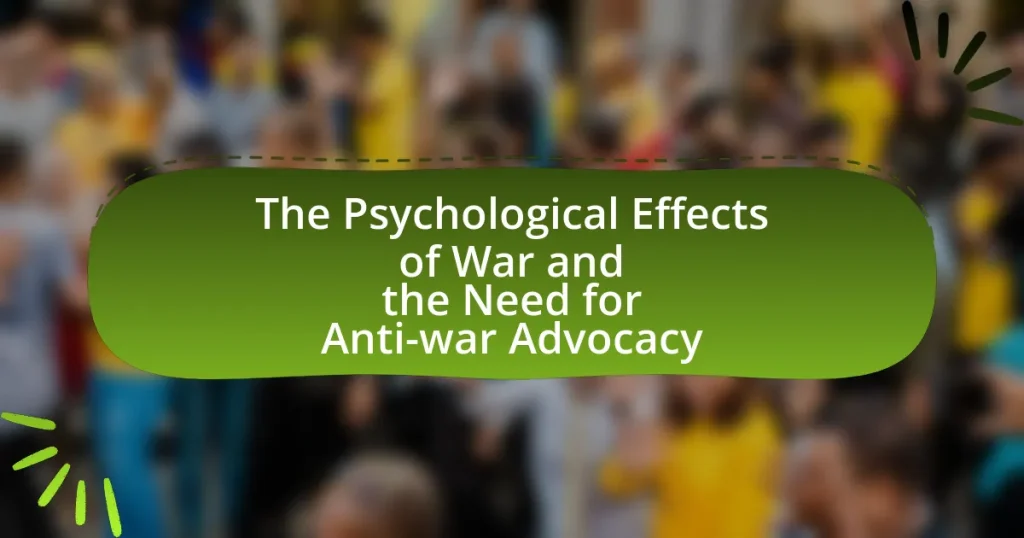The article focuses on the historical analysis of anti-war protests, examining their evolution, significance, and impact on public opinion and government policies. It highlights key historical events that sparked significant movements, such as the Vietnam War and the Iraq War, and discusses how societal attitudes and media influence these protests. The article also explores effective strategies used in past movements, the role of grassroots organizing, and the importance of coalition-building. Additionally, it draws lessons from historical protests to inform current and future anti-war activism, emphasizing the need for sustained engagement and effective communication.

What are Anti-war Protests and Their Historical Context?
Anti-war protests are organized public demonstrations opposing military conflict and advocating for peace. Historically, these protests have emerged during significant wars, such as the Vietnam War in the 1960s and 1970s, where widespread dissent was fueled by opposition to U.S. involvement and the moral implications of warfare. The protests often involved diverse groups, including students, activists, and veterans, who utilized various forms of activism, such as marches, sit-ins, and public speeches, to express their discontent. The effectiveness of these protests is evidenced by their impact on public opinion and policy, contributing to the eventual withdrawal of U.S. troops from Vietnam in 1973.
How have anti-war protests evolved over time?
Anti-war protests have evolved from localized demonstrations to global movements, reflecting changes in communication, political contexts, and public sentiment. Initially, protests during the Vietnam War were characterized by large gatherings and grassroots organizing, often fueled by counterculture and civil rights movements. Over time, the advent of the internet and social media has transformed these protests, enabling rapid mobilization and broader participation across diverse demographics. For instance, the 2003 protests against the Iraq War saw millions worldwide participating, showcasing a significant increase in international solidarity and coordination. This evolution highlights the growing complexity and interconnectedness of anti-war activism, as well as its adaptability to contemporary societal changes.
What key historical events sparked significant anti-war movements?
Key historical events that sparked significant anti-war movements include the Vietnam War, the Iraq War, and World War I. The Vietnam War, particularly the Tet Offensive in 1968, galvanized widespread protests in the United States, as images of the conflict and its casualties were broadcasted, leading to a significant public outcry against U.S. involvement. The Iraq War, initiated in 2003, also saw massive protests globally, driven by claims of weapons of mass destruction that were later proven false, which fueled public disillusionment and activism. World War I prompted anti-war sentiments through the disillusionment with the war’s brutality and the impact of conscription, leading to the formation of organizations like the American Union Against Militarism. These events collectively illustrate how military conflicts can provoke substantial public dissent and mobilization against war.
How did societal attitudes towards war influence these protests?
Societal attitudes towards war significantly influenced anti-war protests by shaping public perception and mobilizing collective action against military conflicts. For instance, during the Vietnam War, widespread disillusionment with government narratives and the human cost of the war led to a surge in protests, as seen in events like the Kent State shootings in 1970, which galvanized public outrage and increased participation in demonstrations. Additionally, the rise of counterculture movements in the 1960s, which promoted peace and civil rights, further fueled anti-war sentiments, resulting in large-scale protests such as the March on the Pentagon in 1967. These societal attitudes, characterized by a growing skepticism of government and a desire for peace, directly correlated with the intensity and frequency of protests during this period.
Why are anti-war protests significant in shaping public opinion?
Anti-war protests are significant in shaping public opinion because they mobilize collective dissent against military actions, influencing perceptions and attitudes toward war. Historical examples, such as the Vietnam War protests in the 1960s and 1970s, demonstrate that large-scale demonstrations can sway public sentiment, leading to decreased support for military engagement. According to a Gallup poll from 1971, public opposition to the Vietnam War surged to 61% following widespread protests, illustrating how grassroots movements can alter the political landscape and compel policymakers to reconsider their strategies.
What role do media and communication play in anti-war movements?
Media and communication play a crucial role in anti-war movements by shaping public perception and mobilizing support. Through various channels, including television, social media, and print, these platforms disseminate information about the consequences of war, highlight personal stories of those affected, and organize protests. For instance, during the Vietnam War, televised images of the conflict significantly influenced public opinion, leading to widespread protests and a shift in policy. Additionally, social media has enabled real-time communication and coordination among activists, exemplified by movements like the Iraq War protests in 2003, where online platforms facilitated global participation. Thus, media and communication are essential tools for raising awareness, fostering solidarity, and driving collective action in anti-war movements.
How do anti-war protests impact government policies?
Anti-war protests significantly influence government policies by creating public pressure that can lead to changes in military engagement and foreign policy. Historical examples, such as the Vietnam War protests in the 1960s and 1970s, demonstrate that widespread public dissent can compel governments to reconsider their military strategies and ultimately withdraw troops. For instance, the protests contributed to a shift in U.S. policy, culminating in the withdrawal of American forces from Vietnam in 1973. This correlation between public dissent and policy change illustrates how anti-war movements can effectively alter governmental decisions regarding military actions.

What Lessons Can Be Learned from Historical Anti-war Protests?
Historical anti-war protests demonstrate the power of collective action in influencing public opinion and policy. For instance, the Vietnam War protests in the 1960s and 1970s significantly swayed American sentiment against the war, leading to a shift in government policy and eventual withdrawal. These protests highlighted the importance of grassroots mobilization, as seen in the large-scale demonstrations organized by groups like Students for a Democratic Society, which galvanized widespread participation. Additionally, historical anti-war movements reveal the effectiveness of diverse strategies, including peaceful protests, civil disobedience, and artistic expression, in conveying dissent and fostering dialogue. The impact of these protests is evidenced by the eventual legislative changes, such as the War Powers Act of 1973, which aimed to limit presidential power in military engagements.
What strategies have proven effective in past anti-war movements?
Effective strategies in past anti-war movements include mass mobilization, grassroots organizing, and coalition-building. Mass mobilization, exemplified by the Vietnam War protests, demonstrated the power of large-scale demonstrations to influence public opinion and policy. Grassroots organizing, as seen in the Civil Rights Movement’s anti-war efforts, empowered local communities to engage in activism and fostered a sense of ownership over the movement. Coalition-building, such as the collaboration between various social justice groups during the Iraq War protests, amplified voices and resources, creating a united front against war. These strategies have historically proven successful in raising awareness, garnering public support, and pressuring governments to reconsider military actions.
How did grassroots organizing contribute to the success of these protests?
Grassroots organizing significantly contributed to the success of these protests by mobilizing local communities and fostering a sense of collective action. This approach enabled individuals to connect on a personal level, creating networks that facilitated communication, resource sharing, and strategic planning. For instance, during the Vietnam War protests, grassroots organizations like Students for a Democratic Society effectively coordinated mass demonstrations, leveraging social media and community meetings to amplify their message. This grassroots framework not only increased participation but also sustained momentum over time, as evidenced by the large turnouts at events such as the Moratorium to End the War in Vietnam, which drew millions of participants nationwide.
What role did art and culture play in anti-war activism?
Art and culture played a crucial role in anti-war activism by serving as powerful tools for expression and mobilization. Artistic works, such as music, literature, and visual arts, conveyed messages of dissent and human suffering, effectively raising awareness about the consequences of war. For instance, the Vietnam War era saw the emergence of protest songs like “Fortunate Son” by Creedence Clearwater Revival, which criticized social inequalities and the draft system, galvanizing public sentiment against the war. Additionally, visual art movements, such as the anti-war posters and graffiti, visually represented the horrors of conflict, influencing public opinion and encouraging activism. Historical evidence shows that cultural events, like the Woodstock Festival in 1969, became platforms for anti-war sentiments, uniting diverse groups in opposition to military actions. Thus, art and culture not only reflected societal discontent but also actively shaped the anti-war movement’s narrative and engagement.
What challenges did historical anti-war protests face?
Historical anti-war protests faced significant challenges, including government repression, public apathy, and internal divisions. Government repression manifested through police violence, arrests, and legal restrictions aimed at suppressing dissent, as seen during the Vietnam War protests when law enforcement often clashed with demonstrators. Public apathy hindered mobilization efforts, as many citizens either supported the war or were indifferent to the protests, limiting the movement’s reach and impact. Additionally, internal divisions among activists regarding strategies and goals created fragmentation, weakening the overall effectiveness of the protests, exemplified by the differing approaches between pacifists and more radical factions within the anti-war movement.
How did government responses shape the outcomes of these protests?
Government responses significantly influenced the outcomes of anti-war protests by determining the level of repression or concession offered to demonstrators. For instance, in the United States during the Vietnam War, the government’s heavy-handed tactics, such as the deployment of police and the use of tear gas, often escalated tensions and led to larger, more organized protests, as seen in the Kent State shootings of 1970, which galvanized public opinion against the war. Conversely, in instances where governments engaged in dialogue or made concessions, such as the withdrawal of troops or policy changes, protests tended to dissipate more quickly, as seen in the case of the U.S. withdrawal from Vietnam in 1973, which was partly a response to sustained public pressure. These patterns illustrate that government actions, whether repressive or conciliatory, directly shaped the trajectory and effectiveness of protest movements.
What lessons can be drawn from the failures of past movements?
Failures of past movements reveal critical lessons about the importance of clear objectives and effective communication. For instance, the anti-Vietnam War movement struggled due to a lack of unified goals, leading to fragmentation and diminished impact. Historical analysis shows that movements with specific, achievable aims, such as the Civil Rights Movement, were more successful in mobilizing support and achieving legislative change. Additionally, the failure to engage diverse communities often resulted in missed opportunities for broader coalitions, as seen in the anti-globalization protests of the late 1990s, which lacked inclusivity. These examples underscore the necessity for strategic planning and coalition-building to enhance the effectiveness of social movements.

How Can Current and Future Anti-war Movements Benefit from Historical Analysis?
Current and future anti-war movements can benefit from historical analysis by learning effective strategies and understanding the socio-political contexts that shaped past movements. Historical analysis reveals how movements like the Vietnam War protests utilized grassroots organizing, coalition-building, and media engagement to amplify their messages, leading to significant political change. For instance, the Vietnam protests demonstrated the power of public demonstrations and the impact of media coverage on public opinion, which can inform contemporary tactics. Additionally, examining the failures and successes of previous movements, such as the anti-Iraq War protests, provides insights into potential pitfalls and effective messaging strategies. This historical context equips current activists with the knowledge to navigate contemporary challenges and mobilize support effectively.
What contemporary issues mirror historical anti-war protests?
Contemporary issues that mirror historical anti-war protests include movements against military interventions, such as the protests against the Iraq War and the ongoing opposition to U.S. involvement in conflicts like those in Syria and Afghanistan. These modern protests reflect similar sentiments seen during the Vietnam War era, where public dissent arose from perceived government overreach and the human costs of war. For instance, the Iraq War protests in 2003 drew millions globally, paralleling the mass mobilizations of the 1960s and 1970s, highlighting a consistent public demand for peace and accountability in military actions.
How can lessons from the past inform current activism strategies?
Lessons from the past can inform current activism strategies by providing insights into effective mobilization techniques and the importance of coalition-building. Historical anti-war protests, such as those during the Vietnam War, demonstrated that grassroots organizing and clear messaging can significantly amplify a movement’s impact. For instance, the Vietnam War protests utilized mass demonstrations, media engagement, and strategic partnerships with various social movements, which led to increased public awareness and political pressure. This historical context illustrates that contemporary activists can adopt similar strategies, focusing on unity and clear communication to address current issues effectively.
What role does technology play in modern anti-war movements?
Technology plays a crucial role in modern anti-war movements by facilitating communication, organization, and mobilization among activists. Social media platforms, such as Twitter and Facebook, enable rapid dissemination of information, allowing movements to reach a global audience and coordinate protests effectively. For instance, during the 2003 Iraq War protests, online platforms were instrumental in organizing large-scale demonstrations, with millions participating worldwide. Additionally, technology provides tools for documenting and sharing evidence of war-related atrocities, which can galvanize public opinion and influence policymakers. The use of hashtags and viral campaigns has also proven effective in raising awareness and fostering solidarity among diverse groups, demonstrating technology’s transformative impact on contemporary anti-war activism.
What best practices can be adopted from historical anti-war protests?
Best practices that can be adopted from historical anti-war protests include grassroots organizing, coalition building, and effective use of media. Grassroots organizing, as seen in the Vietnam War protests, mobilized large numbers of individuals through local community efforts, demonstrating the power of collective action. Coalition building, exemplified by the diverse alliances formed during the Civil Rights Movement and anti-war protests, highlights the importance of uniting various groups to amplify voices and increase impact. Effective use of media, demonstrated by the coverage of protests in the 1960s, shows how strategic communication can shape public perception and influence political discourse. These practices have proven successful in mobilizing support and creating lasting change.
How can coalition-building enhance the effectiveness of current movements?
Coalition-building can enhance the effectiveness of current movements by uniting diverse groups to amplify their collective voice and resources. When various organizations and individuals come together, they can share knowledge, strategies, and networks, which increases their reach and impact. For instance, the Civil Rights Movement in the United States successfully utilized coalition-building by bringing together different civil rights organizations, religious groups, and labor unions, resulting in significant legislative changes such as the Civil Rights Act of 1964. This historical example demonstrates that coalition-building not only strengthens advocacy efforts but also fosters solidarity, making movements more resilient and influential in achieving their goals.
What are the key takeaways for activists today from historical analysis?
Key takeaways for activists today from historical analysis include the importance of coalition-building, the effectiveness of nonviolent resistance, and the need for sustained engagement. Historical anti-war movements, such as the Vietnam War protests, demonstrated that diverse groups united for a common cause can amplify their impact, as seen in the collaboration between civil rights organizations and anti-war activists. Additionally, nonviolent strategies, exemplified by figures like Martin Luther King Jr., have proven to be more effective in garnering public support and achieving long-term change. Lastly, historical movements highlight that activism requires persistence; the anti-war protests of the 1960s and 1970s spanned years, showing that sustained efforts are crucial for influencing policy and public opinion.



